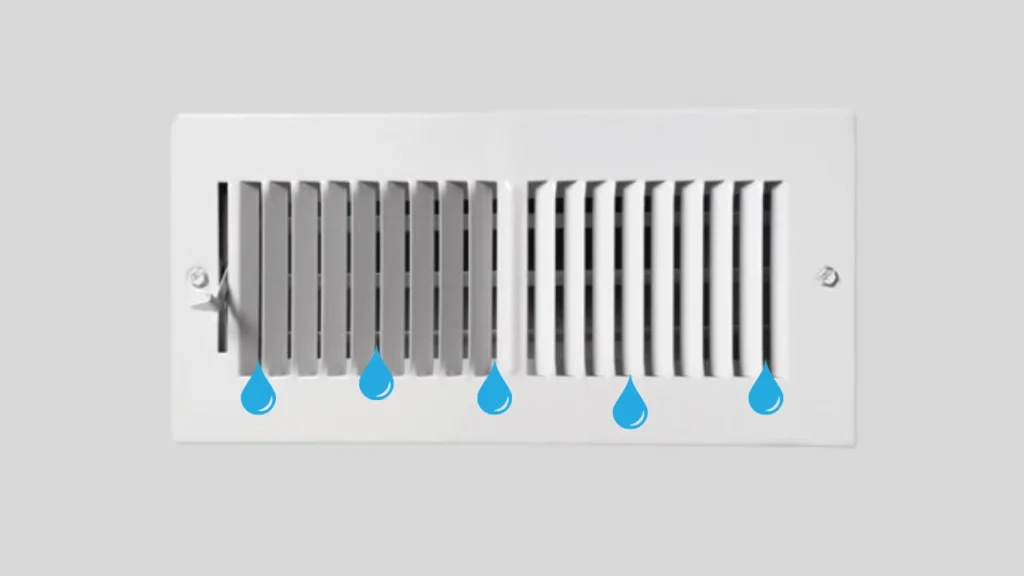
Water dripping from your AC vent is a sign of a hidden problem.
It usually means there’s an issue with airflow, drainage, or insulation.
This isn’t something to ignore, even if the drip seems small.
Left unchecked, it can lead to ceiling damage, mold, or AC failure.
Let’s break down exactly why this happens, what causes it, and what you can do about it.
1. Clogged Drain Line
This is one of the most common causes.
Your AC pulls humidity from the air and drains the moisture through a line.
Over time, dirt, algae, or mold can block this drain line.
When that happens, water backs up into the unit.
With nowhere to go, it may leak from vents or the ceiling.
If you see water dripping and notice a musty smell, it’s likely a clogged line.
You’ll need to clear the drain with a wet/dry vacuum or have a technician flush it out.
2. Dirty Air Filters
Air filters do more than catch dust.
They also protect airflow through your system.
When filters are clogged, the evaporator coil can freeze up.
Once the coil defrosts, the melted ice may drip near vents.
If the water doesn’t flow into the drain pan, it could seep into the ductwork.
This is especially true for attic-mounted systems.
Changing your filter monthly can prevent this issue.
3. Poor Insulation on Ducts
Your air ducts run through warm areas like attics or crawlspaces.
If they’re not properly insulated, warm air can hit the cold metal of the ducts.
This causes condensation—just like water beads on a cold drink.
If the condensation builds up, it drips down through the vent.
You may notice stains on the ceiling or damp spots.
Adding or replacing insulation around your ducts fixes this problem.
4. Damaged or Overflowing Drain Pan
The drain pan sits under your evaporator coil to catch water.
If it’s cracked or rusted, water can leak out.
Sometimes the pan is simply full because the drain is blocked.
Either way, water may travel down ducts and leak from vents.
Older systems are more likely to have damaged pans.
Inspecting or replacing the pan is a quick fix.
5. Low Refrigerant Levels
Refrigerant helps cool your AC coil.
When levels are too low, the coil may get too cold and freeze over.
Like with dirty filters, the ice melts and water leaks out.
This could drip into the ducts or onto vents.
Low refrigerant may also cause hissing sounds or weak cooling.
You’ll need a professional to check levels and repair any leaks.
6. Ductwork Leaks or Disconnections
If your ducts are leaking or have come apart, cool air escapes.
This creates condensation around the loose areas.
It also means the system works harder, increasing humidity.
Excess moisture collects inside the duct and flows toward the vent.
This isn’t just bad for the AC—it wastes energy too.
Sealing duct leaks with tape or mastic stops both water and air loss.
7. High Indoor Humidity Levels
Some areas have naturally high humidity.
If your AC isn’t removing enough moisture, it builds up in the air.
Eventually, the warm, damp air hits the cold surface of the vent.
Water forms and starts to drip down.
This problem may be worse during summer or rainy seasons.
Running a dehumidifier can ease the load on your AC.
8. Incorrect AC Sizing or Poor Installation
An oversized unit cools too quickly and doesn’t remove enough humidity.
Undersized units run too long and overwork the system.
Both situations mess with moisture levels and cause vent condensation.
Improper slope on drain lines during installation can also lead to leaks.
If your system is new but dripping, bad installation may be the root cause.
Getting a second opinion on sizing can save long-term trouble.
9. Blocked or Closed Air Vents
When air vents are closed or blocked by furniture, it restricts airflow.
This can create cold spots and uneven cooling in ducts.
Cool air trapped in one place leads to condensation.
Eventually, water drips from the vent.
Make sure your vents are open and clear of obstructions.
Proper air circulation helps reduce excess moisture.
10. Long-Term Neglect or Lack of Maintenance
Skipping routine AC maintenance builds up small issues.
Over time, they grow into bigger problems like dripping vents.
A clogged drain, dirty coil, and low refrigerant may all hit at once.
Scheduling annual maintenance helps catch these early.
Technicians can clean, inspect, and tune your system for moisture control.
It’s a small investment that prevents big repairs later.
FAQs for Why does water dripping from My AC vent?
Why is water suddenly leaking from my vent?
A sudden leak is often caused by a blocked drain line or frozen coil thawing out.
Is it dangerous if water drips from the AC vent?
Yes. It can lead to mold growth, ceiling damage, and structural issues over time.
Can I fix a dripping vent myself?
You can clean filters and check for visible blockages.
But deeper problems like refrigerant leaks or duct insulation need a pro.
How do I stop my AC vent from dripping permanently?
Fix the root cause—like insulation, drainage, or airflow issues—and schedule regular maintenance.
Should I be worried if the vent only drips occasionally?
Even occasional dripping is a warning sign.
It’s better to investigate early than face ceiling damage later.
Conclusion
Water dripping from your AC vent means something is wrong.
It could be airflow, insulation, drainage, or system sizing.
Each of these problems leads to excess moisture in the system.
Ignoring the drip can lead to mold, rot, or even full system failure.
Inspect your AC, clear blockages, check insulation, and replace old parts when needed.
If you’re unsure, call a technician before the problem grows.
Staying proactive will protect your home, air quality, and wallet.

